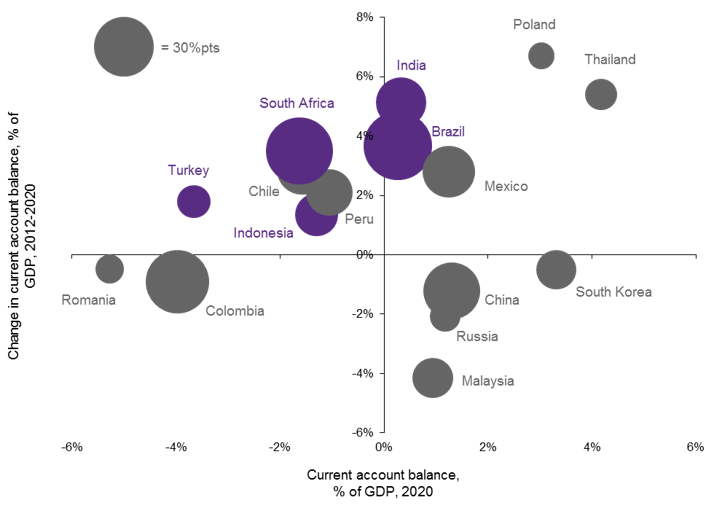Written by: Gabriela Santos
This year’s rise in long-term Treasury yields is bringing back memories of 2013’s “Taper Tantrum” and its negative effects on EM assets. This time around, should investors be as concerned about EM? The reason behind the move higher in bond yields will be important, with a rise in real yields more negative for EM. This has not been the case so far this year, but should it occur, EM countries are better positioned given fewer external vulnerabilities compared to 2013. With that said, investing in EM is about selectivity given differences in internal vulnerabilities between countries.
From May to September 2013, 10-year Treasury yields surged 111 basis points, as investors priced in the Fed’s intention to taper its bond purchases. During this time, EM assets suffered: U.S. dollar sovereign bonds fell -9.6%, equities fell -9.2%, currencies weakened -8.3%, local currency bonds fell -6.0%, and U.S. dollar corporate bonds fell -5.9%. So far this year, 10-year Treasury yields are up 73bps, but EM assets have been more resilient: U.S. dollar sovereign bonds are down -4.0%, equities are up +2.8%, currencies are down -2.7%, local currency bonds are down -3.1%, and U.S. dollar corporate bonds are down -0.7%.
This performance difference is due to why bond yields are moving up this year versus the 2013 episode. In 2013, the move higher in 10-year yields was entirely driven by real yields (up 135bps), while inflation breakevens actually fell 24bps. This time around, the rise in real yields has been more modest (up 43bps) and explains only part of the move, with inflation breakevens increasing 30bps. This distinction matters for EM as now the move up in yields reflects improving nominal growth expectations, rather than a perceived policy error with negative growth implications.
Later this year, we expect the Fed to announce plans to taper its bond purchases, but EM is better positioned should a surge in real yields occur. In 2013, concerns centered on EM countries that had external vulnerabilities (such as large current account deficits), which left them particularly exposed to capital outflows. The “Fragile Five” countries (Brazil, India, Indonesia, South Africa and Turkey) have significantly reduced their current account deficits, from -4.1% of GDP in 2012 to -0.5% in 2020. In fact, there are very few exceptions of countries with worsening current account deficits. However, internal vulnerabilities do exist in EM, such as the rise in sovereign debt. After last year’s pandemic-induced fiscal spending, EM countries now need to return to fiscal responsibility. Those that do not, or that generally engage in unorthodox economic policies, will be left particularly vulnerable.
EM Countries have lower external but higher internal vulnerabilities compared to 2013
Bubble sizes refer to change in government gross debt (% of GDP) 2012-2020

Source: IMF, J.P. Morgan Asset Management. Purple color denotes group of countries classified as the “Fragile Five” in 2013.
Related: How Could Vaccine Hesitancy Affect the Global Recovery?


